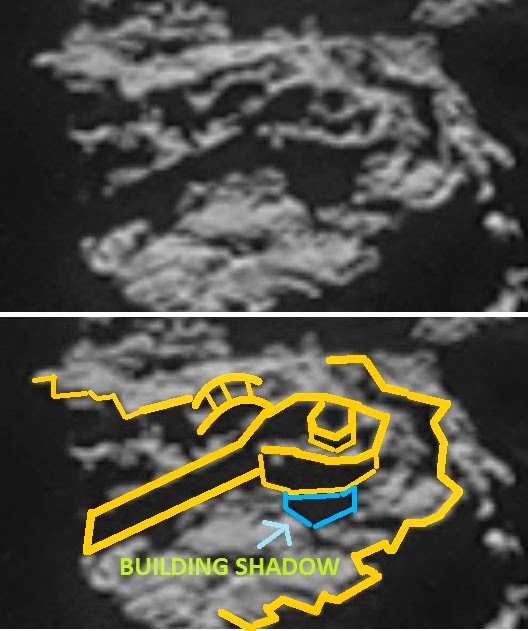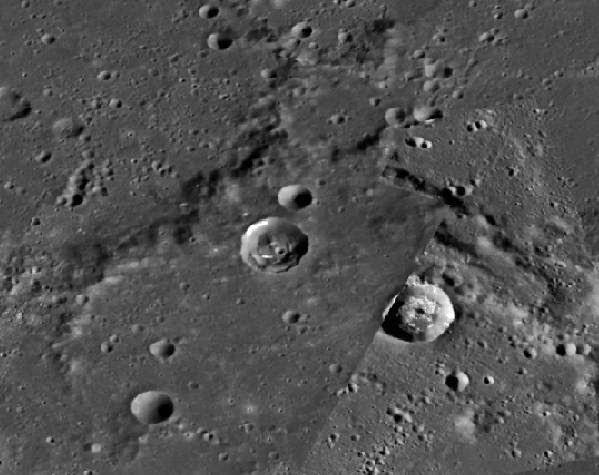Hubble 25th Anniversary: Pillars of Creation
Image Credit:
NASA,
ESA,
and
The Hubble Heritage
Team
(STScI /
AURA)
Explanation:
To
celebrate 25 years (1990-2015) of exploring the Universe from
low Earth orbit, the Hubble Space Telescope's cameras were
used to revisit its most iconic image.
The result is this sharper, wider view of the region dubbed the
Pillars of Creation, first imaged by Hubble in
1995.
Stars are forming deep inside the towering structures.
The light-years long columns of cold gas and dust are some
6,500 light-years
distant in M16, the Eagle Nebula, toward the
constellation Serpens.
Sculpted and eroded by the energetic ultraviolet light and
powerful winds from M16's cluster of young, massive stars,
the cosmic pillars themselves are destined for destruction.
But the turbulent environment of star formation within M16, whose
spectacular
details are captured in this Hubble visible-light
snapshot, is likely similar to the environment that formed our own Sun.
100 Million Stars in the Andromeda Galaxy
Image Credit:
NASA,
ESA,
J. Dalcanton, B. F. Williams, L. C. Johnson
(U. Washington),
PHAT team,
R. Gendler
Explanation:
What stars compose the Andromeda galaxy?
To better understand, a
group of researchers
studied the
nearby spiral
by composing the largest image ever taken with the
Hubble Space Telescope.
The result, called the
Panchromatic Hubble Andromeda Treasury (PHAT), involved thousands of observations,
hundreds of fields,
spanned about a third of the galaxy, and resolved over 100 million stars.
In the
featured
composite image, the
central part of the galaxy is seen on the far left,
while a blue spiral arm is prominent on the right.
The brightest stars, scattered over the frame, are actually
Milky Way foreground stars.
The
PHAT data is being analyzed to
better understand
where and how stars have formed in
M31 in contrast to our
Milky Way Galaxy,
and to identify and characterize Andromeda's
stellar clusters and
obscuring dust.
A Fox Fur, a Unicorn, and a Christmas Tree
Image Credit & Copyright:
R. Colombari &
Francesco Antonucci;
Data:
Subaru,
ESO, & F. Antonucci
Explanation:
What do the following things have in common:
a cone, the fur of a fox, and a Christmas tree?
Answer: they all occur in the constellation of the unicorn
(
Monoceros).
Pictured as a star forming region
and
cataloged as NGC 2264, the complex jumble of
cosmic gas and dust is about 2,700 light-years distant and
mixes reddish
emission nebulae
excited by energetic light from
newborn stars
with dark
interstellar dust clouds.
Where the otherwise obscuring dust clouds lie close
to the hot, young stars they also reflect starlight, forming blue
reflection nebulae.
The
image spans about the diameter of a full moon,
covering about 30
light-years at the distance of NGC 2264.
Its cast of cosmic characters includes
the
Fox Fur Nebula, whose
convoluted pelt lies on the lower right, bright
variable star
S Mon visible just above the Fox Fur, and the
Cone Nebula on the image left.
Given their distribution, the stars of NGC 2264 are also known as the
Christmas Tree
star cluster.
The triangular tree shape traced by the stars appears here
with its apex at the
Cone Nebula on the left with its broader base
near
S Mon on the right.
Apollo 17: A Stereo View from Lunar Orbit
Image Credit:
Gene
Cernan,
Apollo 17,
NASA;
Anaglyph by
Patrick Vantuyne
Explanation:
Get out your
red/blue glasses and
check out this awesome stereo view of another world.
The scene was recorded
by Apollo 17 mission commander
Eugene Cernan on December 11, 1972,
one orbit before descending to land on the Moon.
The stereo anaglyph was assembled from two photographs
(
AS17-147-22465, AS17-147-22466)
captured from his vantage point on board the
Lunar Module Challenger as he
and Dr. Harrison Schmitt flew over Apollo 17's
landing site in the
Taurus-Littrow
Valley.
The broad, sunlit face of the mountain dubbed
South Massif rises near the center
of the frame, above the dark floor of
Taurus-Littrow to its left.
Beyond the mountains, toward the lunar limb, lies the Moon's
Mare Serenitatis.
Piloted by Ron Evans, the Command Module America is
visible in orbit in the foreground against the
South Massif's peak.
Crescent Rhea Occults Crescent Saturn
Image Credit:
Cassini Imaging Team,
SSI,
JPL,
ESA,
NASA
Explanation:
Soft hues, partially lit orbs, a thin trace of the ring, and slight
shadows highlight this understated view of the majestic surroundings of
the giant planet Saturn.
Looking nearly back toward the Sun, the
robot Cassini
spacecraft now orbiting Saturn captured
crescent phases of
Saturn
and its
moon Rhea in color a few years ago.
As striking as the
above image is, it is but a single frame from a
60-frame silent movie where Rhea can be seen gliding in front of its parent world.
Since Cassini was nearly in the plane of
Saturn's rings, the normally impressive rings are visible here only as a
thin line across the image center.
At the Heart of Orion
Image Credit &
Copyright:
László Francsics
Explanation:
Near the center of
this
sharp cosmic portrait, at
the heart of
the
Orion Nebula, are four hot, massive stars
known as
the Trapezium.
Tightly gathered within a region about 1.5 light-years in radius,
they dominate the core of the dense Orion Nebula Star Cluster.
Ultraviolet ionizing radiation from the Trapezium stars,
mostly from the brightest star
Theta-1
Orionis C
powers the complex star forming region's entire visible glow.
About three million years old, the Orion Nebula Cluster was
even more compact in its younger years and a
dynamical study
indicates that
runaway stellar collisions
at an earlier age may have formed a black hole
with more than 100 times the mass of the Sun.
The presence of a black hole within the cluster
could explain the observed high velocities of the Trapezium stars.
The Orion Nebula's distance of some 1,500 light-years
would make it the closest known black hole to planet Earth.
Observatory, Mountains, Universe
Image Credit & Copyright:
Boris Dmitriev
(Night Scape)
Explanation:
The awesomeness in this image comes in layers.
The closest layer, in the foreground, contains the
Peak Terskol
Observatory located in the northern
Caucasus Mountains of
Russia.
The white
dome over the 2-meter telescope is clearly visible.
The observatory is located on a shoulder of
Mt. Elbrus, the highest mountain in
Europe,
with other peaks visible in a nearby background layer.
Clouds are visible both in front of and behind the mountain peaks.
The
featured three-image composite panorama was taken in 2014 August.
Far in the distance is the most distant layer: the stars and nebulas of the night sky, with the
central band of the
Milky Way
rising on the image right.
Unusual Light Pillars over Latvia
Image Credit &
Copyright:
Aigar Truhin
Explanation:
What's happening over that town?
Close inspection shows these strange columns of light occur over bright lights,
and so likely are
light pillars that involve falling
ice crystals reflecting back these lights.
The
above image and several similar images were taken with a standard digital camera in
Sigulda,
Latvia in late 2009.
The reason why these pillars fan out at the top, however,
remains a topic for speculation.
The air was noted to be quite cold and indeed filled with small ice
crystals, just the type known to create several awe-inspiring but well
known
sky phenomena such as
light pillars,
sun pillars,
sun dogs, and
moon halos.
The cold and
snowy winter occurring this year in parts of Earth's northern hemisphere is giving
sky enthusiasts new and typically unexpected opportunities to see several of these unusual optical
atmospheric phenomena for themselves.
Cetus Duo M77 and NGC 1055
Image Credit & Copyright:
Dieter Willasch
(Astro-Cabinet)
Explanation:
At the top right,
large spiral galaxy NGC 1055 joins
spiral Messier 77 in this
sharp cosmic view
toward the aquatic
constellation
Cetus.
The narrowed, dusty appearance of edge-on spiral
NGC 1055
contrasts nicely with the face-on view of
M77's bright nucleus
and spiral arms.
Both over 100,000 light-years across, the pair are dominant members
of a small galaxy group about 60 million light-years away.
At that estimated distance,
M77 is one
of the most remote objects in
Charles Messier's catalog and
is separated from fellow island universe NGC 1055 by at
least 500,000 light-years.
The field of view is about the size of the full Moon
on the sky
and
includes colorful foreground Milky Way stars (with diffraction
spikes)
along with more distant background galaxies
The Sun in X-rays from NuSTAR
Image Credit:
NuSTAR,
SDO,
NASA
Explanation:
Why are the regions above sunspots so hot?
Sunspots themselves are a bit cooler than the surrounding solar surface because the magnetic fields that create them reduce
convective heating.
It is therefore unusual that regions overhead -- even much higher up in the Sun's corona -- can be hundreds of times hotter.
To help find the cause,
NASA directed the Earth-orbiting
Nuclear Spectroscopic Telescope Array (NuSTAR)
satellite to point its very sensitive X-ray telescope at the Sun.
Featured above is the Sun in ultraviolet light,
shown
in a red hue as taken by the orbiting
Solar Dynamics Observatory (SDO).
Superimposed in false-colored green and blue is emission above sunspots detected by
NuSTAR in different bands of
high-energy
X-rays,
highlighting regions of extremely
high temperature.
Clues about the Sun's atmospheric
heating
mechanisms may not only come from this initial image,
but future NuSTAR images aimed at finding hypothesized
nanoflares,
brief bursts of energy that may drive the unusual heating.
Source -
www.nasa.gov




































